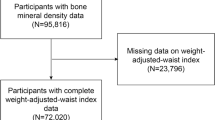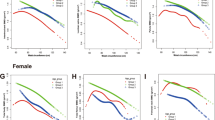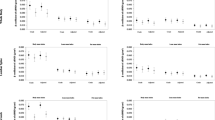Abstract
Summary
All obesity measures were positively associated with femoral neck bone mineral density (BMD), but not with lumbar spine BMD. Hip circumference was the most important obesity measure in relation to BMD.
Purpose
Multiple measures are used to quantify obesity; different obesity measures have diverse relationship with BMD. Which obesity measure has the most important value in relation to BMD is still poorly understood. We examined the association between multiple obesity measures and BMD and determined the relative importance (RI, percentage of variation) of multiple obesity measures associated with BMD.
Methods
Data from 5287 men and women aged between 8 and 69 years (mean age = 29 years) in the National Health and Nutrition Examination Survey 2005–2006 were analyzed. Body mass index (BMI), waist circumference, hip circumference, body fat mass (FM) index, total body FM, abdominal FM, and appendicular FM were considered the exposures and femoral neck and lumbar spine BMD the outcomes.
Results
In the multivariable analysis, greater BMI and hip circumference were associated with increased BMD at the lumbar spine and femoral neck (all P < 0.001). The remaining obesity variables were positively associated with increased femoral neck BMD only (all P < 0.001). RI of all obesity measures associated with femoral neck BMD was much greater than that associated with lumbar spine BMD. Moreover, hip circumference had higher RI (19.8 for femoral neck BMD; 7.0 for lumbar spine BMD) than other obesity measures (all RIs ≤14.1 for femoral neck BMD; all RIs ≤3.5 for lumbar spine BMD) in relation to BMD.
Conclusions
All obesity measures were positively associated with femoral neck BMD, but not with lumbar spine BMD. Hip circumference was the most important obesity measure in relation to BMD.
Similar content being viewed by others
References
Eckel RH (1997) Obesity and heart disease: a statement for healthcare professionals from the Nutrition Committee, American Heart Association. Circulation 96:3248–3250
Aneja A, El-Atat F, McFarlane SI, Sowers JR (2004) Hypertension and obesity. Recent Prog Horm Res 59:169–205
Yatsuya H, Folsom AR, Yamagishi K, North KE, Brancati FL, Stevens J, Atherosclerosis Risk in Communities Study I (2010) Race- and sex-specific associations of obesity measures with ischemic stroke incidence in the Atherosclerosis Risk in Communities (ARIC) study. Stroke; J Cereb Circ 41:417–425
Bloomgarden ZT (2000) Obesity and diabetes. Diabetes Care 23:1584–1590
Kissebah AH, Vydelingum N, Murray R, Evans DJ, Hartz AJ, Kalkhoff RK, Adams PW (1982) Relation of body fat distribution to metabolic complications of obesity. J Clin Endocrinol Metab 54:254–260
Larsson B, Svardsudd K, Welin L, Wilhelmsen L, Bjorntorp P, Tibblin G (1984) Abdominal adipose tissue distribution, obesity, and risk of cardiovascular disease and death: 13 year follow up of participants in the study of men born in 1913. Br Med J 288:1401–1404
Heitmann BL, Frederiksen P, Lissner L (2004) Hip circumference and cardiovascular morbidity and mortality in men and women. Obes Res 12:482–487
Yang SM, Nguyen ND, Center JR, Eisman JA, Nguyen TV (2013) Association between abdominal obesity and fracture risk: a prospective study. J Clin Endocrinol Metab 98:2478–2483
Wiklund P, Toss F, Weinehall L, Hallmans G, Franks PW, Nordstrom A, Nordstrom P (2008) Abdominal and gynoid fat mass are associated with cardiovascular risk factors in men and women. J Clin Endocrinol Metab 93:4360–4366
Choi JW, Pai SH, Kim SK (2002) Associations between total body fat and serum lipid concentrations in obese human adolescents. Ann Clin Lab Sci 32:271–278
Asomaning K, Bertone-Johnson ER, Nasca PC, Hooven F, Pekow PS (2006) The association between body mass index and osteoporosis in patients referred for a bone mineral density examination. J Womens Health 15:1028–1034
Hsu YH, Venners SA, Terwedow HA et al (2006) Relation of body composition, fat mass, and serum lipids to osteoporotic fractures and bone mineral density in Chinese men and women. Am J Clin Nutr 83:146–154
Salamone LM, Glynn N, Black D, Epstein RS, Palermo L, Meilahn E, Kuller LH, Cauley JA (1995) Body composition and bone mineral density in premenopausal and early perimenopausal women. J Bone Miner Res Off J Am Soc Bone Miner Res 10:1762–1768
Morin S, Tsang JF, Leslie WD (2009) Weight and body mass index predict bone mineral density and fractures in women aged 40 to 59 years. Osteoporos Int 20:363–370
Kim KC, Shin DH, Lee SY, Im JA, Lee DC (2010) Relation between obesity and bone mineral density and vertebral fractures in Korean postmenopausal women. Yonsei Med J 51:857–863
Greco EA, Fornari R, Rossi F et al (2010) Is obesity protective for osteoporosis? Evaluation of bone mineral density in individuals with high body mass index. Int J Clin Pract 64:817–820
Beck TJ, Petit MA, Wu GL, LeBoff MS, Cauley JA, Chen Z (2009) Does obesity really make the femur stronger? BMD, geometry, and fracture incidence in the women’s health initiative-observational study. J Bone Miner Res 24:1369–1379
Ho-Pham LT, Nguyen ND, Lai TQ, Nguyen TV (2010) Contributions of lean mass and fat mass to bone mineral density: a study in postmenopausal women. BMC Musculoskelet Disord 11:59
Nguyen TV, Howard GM, Kelly PJ, Eisman JA (1998) Bone mass, lean mass, and fat mass: same genes or same environments? Am J Epidemiol 147:3–16
Marques EA, Moreira P, Wanderley F, Pizarro AN, Leao-Rosas JP, Mota J, Carvalho J (2012) Appendicular fat mass is positively associated with femoral neck bone mineral density in older women. Menopause 19:311–318
Gilthorpe MS, Tu YK (2004) Mathematical coupling: a multilevel approach. Int J Epidemiol 33:1399–1400
De Laet C, Kanis JA, Oden A et al (2005) Body mass index as a predictor of fracture risk: a meta-analysis. Osteoporos Int 16:1330–1338
Zillikens MC, Uitterlinden AG, van Leeuwen JPTM, Berends AL, Henneman P, van Dijk KW, Oostra BA, van Duijn CM, Pols HAP, Rivadeneira F (2010) The role of body mass index, insulin, and adiponectin in the relation between fat distribution and bone mineral density. Calcif Tissue Int 86:116–125
Gromping U (2006) Relative importance for linear regression in R: the package relaimpo. J Stat Softw 17:1–27
Johnson JW, LeBreton JM (2004) History and use of relative importance indices in organizational research. Organ Res Methods 7:238–257
Yang SM, Nguyen ND, Center JR, Eisman JA, Nguyen TV (2011) Association between beta-blocker use and fracture risk: the Dubbo Osteoporosis Epidemiology Study. Bone 48:451–455
Tucker KL, Chen HL, Hannan MT, Cupples LA, Wilson PWF, Felson D, Kiel DP (2002) Bone mineral density and dietary patterns in older adults: the Framingham Osteoporosis Study. Am J Clin Nutr 76:245–252
Etherington J, Harris PA, Nandra D, Hart DJ, Wolman RL, Doyle DV, Spector TD (1996) The effect of weight-bearing exercise on bone mineral density: a study of female ex-elite athletes and the general population. J Bone Miner Res Off J Am Soc Bone Miner Res 11:1333–1338
Zernicke R, MacKay C, Lorincz C (2006) Mechanisms of bone remodeling during weight-bearing exercise. Appl Physiol Nutr Metab = Physiol Appl Nutr Metab 31:655–660
Kuruvilla SJ, Fox SD, Cullen DM, Akhter MP (2008) Site specific bone adaptation response to mechanical loading. J Musculoskelet Neuronal Interact 8:71–78
Snijder MB, Zimmet PZ, Visser M, Dekker JM, Seidell JC, Shaw JE (2004) Independent and opposite associations of waist and hip circumferences with diabetes, hypertension and dyslipidemia: the AusDiab Study. Int J Obes Relat Metab Disord 28:402–409
Nguyen NT, Magno CP, Lane KT, Hinojosa MW, Lane JS (2008) Association of hypertension, diabetes, dyslipidemia, and metabolic syndrome with obesity: findings from the National Health and Nutrition Examination Survey, 1999 to 2004. J Am Coll Surg 207:928–934
Yang S, Nguyen ND, Center JR, Eisman JA, Nguyen TV (2014) Association between hypertension and fragility fracture: a longitudinal study. Osteoporos Int 25:97–103
Tuominen JT, Impivaara O, Puukka P, Ronnemaa T (1999) Bone mineral density in patients with type 1 and type 2 diabetes. Diabetes Care 22:1196–1200
Tu YK, Clerehugh V, Gilthorpe MS (2004) Ratio variables in regression analysis can give rise to spurious results: illustration from two studies in periodontology. J Dent 32:143–151
Reid IR (2008) Relationships between fat and bone. Osteoporos Int 19:595–606
Grumbach MM (2000) Estrogen, bone, growth and sex: a sea change in conventional wisdom. J Pediatr Endocrinol Metab 13:1439–1455
Thomas T, Burguera B (2002) Is leptin the link between fat and bone mass? J Bone Miner Res 17:1563–1569
Ducy P, Amling M, Takeda S, Priemel M, Schilling AF, Beil FT, Shen JH, Vinson C, Rueger JM, Karsenty G (2000) Leptin inhibits bone formation through a hypothalamic relay: a central control of bone mass. Cell 100:197–207
Cao JJ (2011) Effects of obesity on bone metabolism. J Orthop Surg Res 6:30
Acknowledgments
The current study has no funding body. We thank Dr. Ann Voung for editing our manuscript.
Conflicts of interest
None.
Author information
Authors and Affiliations
Corresponding author
Electronic supplementary material
Below is the link to the electronic supplementary material.
Supplemental Table 1
Association between demographic variables, obesity variables stratified by quintiles of lumbar spine BMD. Values are means, unless otherwise specified. ±Values with skew distribution is shown in median. (DOC 48 kb)
Supplemental Table 2
Association between demographic variables, obesity variables stratified by quintiles of femoral neck BMD. Values are means, unless otherwise specified. ±Values with skew distribution is shown in median. (DOC 47 kb)
Supplemental Table 3
Association between obesity measures and BMD stratified by age. *Values are approximately 1 SD. The rest values are displayed in β (P value), and were adjusted for age (continuous), gender (male and female; only in overall analysis), body height (continuous), physical activity (in quartiles), alcohol intake (1–2 and 3+ drinks/day), smoking status (current, past and never smoker), history of diabetes (yes/no), history of hypertension (yes/no), race (Mexican American, Hispanic, Non-Hispanic White, Non-Hispanic Black, and others) and survey weights. (DOC 37 kb)
Rights and permissions
About this article
Cite this article
Yang, S., Shen, X. Association and relative importance of multiple obesity measures with bone mineral density: the National Health and Nutrition Examination Survey 2005–2006. Arch Osteoporos 10, 14 (2015). https://doi.org/10.1007/s11657-015-0219-2
Received:
Accepted:
Published:
DOI: https://doi.org/10.1007/s11657-015-0219-2




